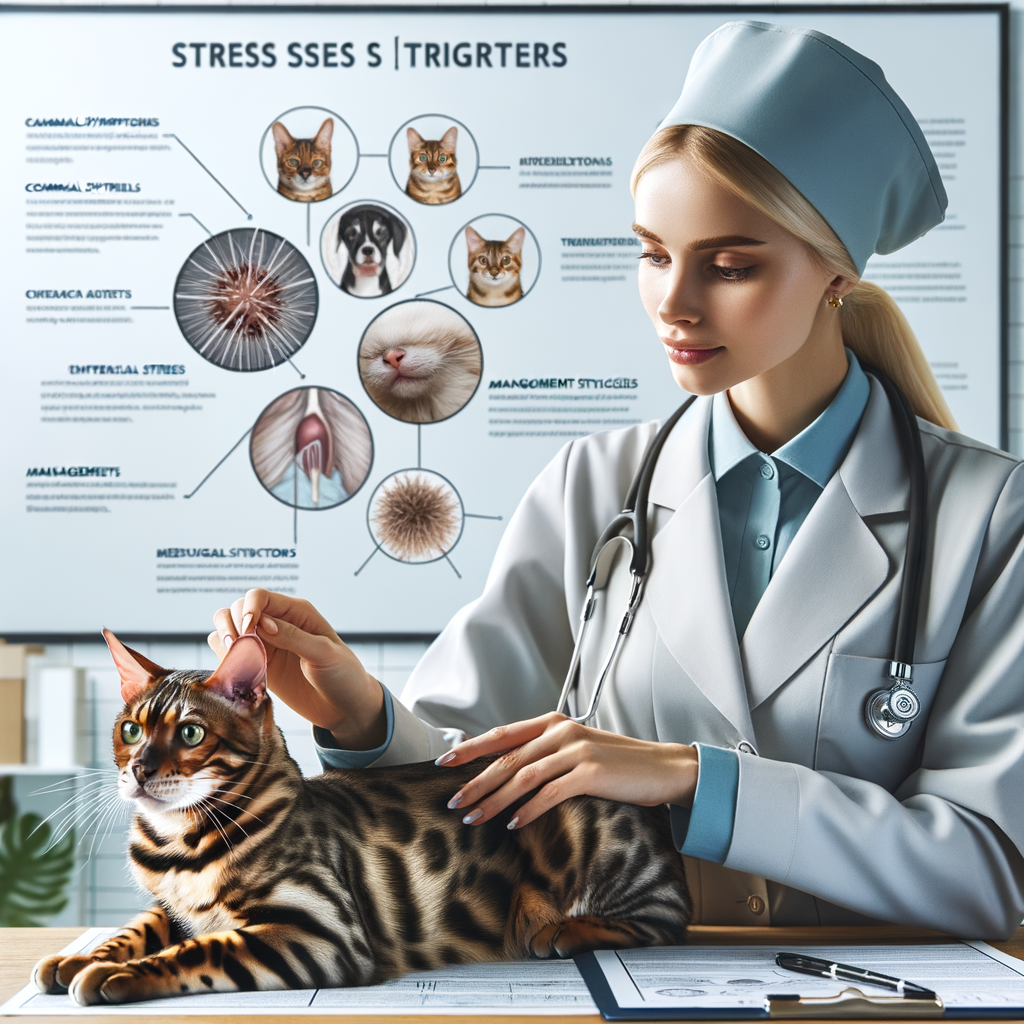
Introduction to Bengal Cats and Stress
When we talk about pets, one of the most fascinating and unique breeds to consider is the Bengal cat. These cats are known for their strikingly beautiful coat and active lifestyle. However, like any other pet, Bengal cats can also experience stress. In this article, we will delve into understanding Bengal cats and defining what stress looks like in these felines.
Bengal cats are a hybrid breed developed by crossing a domestic feline with an Asian leopard cat. This gives them their distinctive wild appearance. Despite their wild ancestry, Bengal cats are incredibly friendly and playful, making them excellent companions.
They are highly active and require plenty of stimulation. Without it, they can become bored and potentially stressed. Understanding their needs and behavior is crucial to ensuring their well-being.
Just like humans, cats can also experience stress. Stress in cats can be defined as a state of mental or emotional strain resulting from adverse or demanding circumstances. It can be caused by a variety of factors, including changes in their environment, lack of stimulation, or health issues.
Stress can manifest in various ways in cats, such as changes in behavior, eating habits, or litter box use. Recognizing these signs is key to managing and reducing stress in your Bengal cat.
In the following sections, we will explore how to identify stress in Bengal cats, what triggers it, and how to manage it effectively. We will also delve into the potential issues related to stress and share some real-life case studies for a better understanding.
Identifying Stress in Bengal Cats
Stress in Bengal cats can manifest in various ways. It is crucial for cat owners to recognize these signs early to help their furry friends lead a healthier and happier life. Let’s delve into the common symptoms of stress in Bengal cats.
Bengal Cats Stress Symptoms
Stress symptoms in Bengal cats can be broadly categorized into two types: physical and behavioral symptoms.
-
- Physical Symptoms
Physical symptoms are often the first signs of stress in Bengal cats. These can include:
-
-
- Changes in appetite or weight
- Excessive grooming or hair loss
- Unusual vocalizations
- Changes in litter box habits
-
It’s important to note that these symptoms can also be signs of other health issues, so it’s crucial to consult with a vet if you notice any changes in your cat’s physical condition.
-
- Behavioral Symptoms
Behavioral symptoms are often more subtle than physical symptoms, but they can be just as telling. These can include:
-
-
- Changes in sleep patterns
- Aggression or withdrawal
- Excessive meowing or yowling
- Changes in play habits
-
Again, it’s important to remember that these behaviors can also be signs of other issues, so it’s always best to consult with a professional if you’re concerned about your cat’s behavior.
Identifying stress in Bengal cats is the first step towards helping them. By understanding these symptoms, you can take the necessary steps to alleviate their stress and improve their overall well-being.
Bengal Cats Behavior Under Stress
When Bengal cats are under stress, their behavior can change in several noticeable ways. This can include alterations in their eating and sleeping habits, as well as shifts in their overall demeanor. Let’s explore these changes in detail:
-
- Changes in Eating Habits
Under stress, a Bengal cat’s eating habits may change significantly. They may start eating less than usual, or in some cases, they might stop eating altogether. This is a clear sign of distress and should not be ignored. On the other hand, some cats might start overeating as a coping mechanism. Any sudden change in your Bengal cat’s eating habits warrants attention.
-
- Changes in Sleeping Patterns
Another common sign of stress in Bengal cats is a change in their sleeping patterns. Cats are known for their love of sleep, but a stressed Bengal cat might sleep more than usual or, conversely, suffer from insomnia. If your cat is sleeping all day or is restless and unable to sleep, it could be a sign that they are dealing with stress.
-
- Aggressive or Withdrawn Behavior
Stress can also cause a Bengal cat to become either aggressive or withdrawn. If your normally friendly and playful Bengal cat suddenly becomes aggressive, hissing or scratching without provocation, they might be feeling stressed. Similarly, if your cat becomes unusually quiet, hides, or avoids interaction, it could be a sign of stress. It’s important to remember that these behaviors are not the cat’s fault, but rather a response to feeling overwhelmed.
Understanding these signs of stress in your Bengal cat is the first step towards helping them. Remember, if you notice any of these behaviors, it’s important to consult with a veterinarian or a cat behaviorist to find the best ways to alleviate your cat’s stress.
Stress Signs in Bengal Cats
Stress is a common issue that can affect any cat, including the Bengal breed. It’s important to recognize the signs of stress in your Bengal cat so you can take steps to help them feel better. Let’s start by exploring the immediate signs of stress.
Immediate Signs
There are several immediate signs that your Bengal cat may be stressed. These signs can appear suddenly and are usually quite noticeable. Here are a couple of the most common immediate signs:
-
- Excessive Grooming: Cats are known for their grooming habits, but excessive grooming can be a sign of stress. If your Bengal cat is grooming more than usual, or if they are grooming to the point of causing bald spots or skin irritation, this could be a sign of stress.
Excessive grooming is a way for cats to self-soothe and control their environment. It’s similar to how some people bite their nails or twirl their hair when they’re nervous. If you notice this behavior in your Bengal cat, it’s important to address the underlying cause of the stress.
-
- Unusual Vocalization: Bengal cats are known for their vocal nature. However, if your Bengal cat is making noises that are unusual for them, or if they are vocalizing more than usual, this could be a sign of stress.
Unusual vocalization can include increased frequency of meowing, changes in the tone or volume of their meow, or making noises that they don’t typically make. This is another way that Bengal cats may express their stress or discomfort.
Recognizing these immediate signs of stress in your Bengal cat is the first step towards helping them. In the next section, we’ll discuss the long-term signs of stress, which can be more subtle but just as important to recognize.
Long-Term Signs of Stress in Bengal Cats
While immediate signs of stress in Bengal cats are often easy to spot, long-term signs may be more subtle, but they are equally important. These signs may take weeks or even months to become noticeable. Let’s delve into two of the most common long-term signs of stress in Bengal cats.
-
- Weight Loss or Gain
Significant changes in your Bengal cat’s weight can be a clear indication of stress. If your cat is losing weight rapidly without any changes in diet or exercise, it could be due to stress. On the other hand, some cats may react to stress by overeating, leading to weight gain. It’s crucial to monitor your cat’s weight and consult a vet if you notice any drastic changes.
-
- Changes in Coat Condition
A Bengal cat’s coat is usually glossy and thick. However, prolonged stress can affect the condition of your cat’s coat. You might notice that their fur becomes dull, thin, or starts to shed excessively. This change is often a result of your cat grooming less frequently due to feeling stressed or anxious. If you notice any changes in your cat’s coat, it’s time to take action and find ways to reduce their stress levels.
In conclusion, long-term signs of stress in Bengal cats, such as weight loss or gain and changes in coat condition, are often overlooked but are equally important. As a responsible cat owner, you should keep a close eye on these signs and take appropriate action to ensure your cat’s well-being.
Bengal Cats Stress Triggers
Just like humans, Bengal cats can also experience stress. It’s essential to understand what can trigger stress in your Bengal cat to help manage it effectively. Here are some of the most common stress triggers:
-
- New Environment
Bengal cats are creatures of habit and comfort. They thrive in familiar surroundings and can become stressed when introduced to a new environment. This could be a new house, a new room, or even a new piece of furniture. The unfamiliar scents and sights can be overwhelming for them, leading to stress.
-
- Changes in Routine
Bengal cats are routine-oriented animals. They like to eat, play, and sleep at the same time every day. Any significant changes in their daily routine can cause them stress. This could be a change in feeding time, a new brand of cat food, or a change in the time you usually play with them.
-
- Conflict with Other Pets
Bengal cats are generally sociable and get along well with other pets. However, conflicts can arise, especially if the other pet is new or if they feel their territory is being threatened. This can lead to a lot of stress for your Bengal cat.
Understanding these triggers can help you create a more comfortable and stress-free environment for your Bengal cat. Remember, a happy cat is a healthy cat!
Managing Stress in Bengal Cats
Stress can significantly impact the overall health and happiness of your Bengal cat. Fortunately, there are several effective techniques you can use to manage and reduce stress in your feline friend.
Bengal Cats Stress Management Techniques
Here are three key techniques that can help manage stress in Bengal cats:
-
- Providing a Safe Space
Just like humans, cats also need a safe and comfortable space where they can retreat when they feel stressed or anxious. This space could be a quiet room, a cozy corner, or even a special cat bed. Ensure this space is always accessible to your cat and free from loud noises or other pets.
-
- Consistent Routine
Cats are creatures of habit and thrive on routine. A consistent daily routine for feeding, playtime, and rest can provide a sense of security and reduce stress in Bengal cats. Try to feed your cat, clean their litter box, and play with them at the same times every day.
-
- Interactive Play
Interactive play is not just fun for your cat, but it’s also a great stress reliever. Use toys that mimic prey, like feather wands or laser pointers, to engage your cat in a game of chase. This can help them burn off energy and reduce feelings of stress.
By implementing these stress management techniques, you can help ensure your Bengal cat leads a happy, stress-free life. Remember, every cat is unique, so it may take some time to figure out what works best for your feline friend.
Professional Help for Bengal Cats Under Stress
When it comes to managing stress in Bengal cats, professional help can be invaluable. There are two primary sources of professional assistance that can be sought: veterinary consultation and behavioral therapists. Both of these professionals can provide specialized knowledge and guidance to help your Bengal cat cope with stress.
- Veterinary Consultation
Firstly, a veterinary consultation is crucial. Veterinarians are trained to understand the physical and emotional health of animals. They can perform a thorough examination to rule out any medical conditions that could be causing your cat’s stress. For instance, a cat might be stressed due to an underlying health issue like a urinary tract infection or a thyroid problem. A vet can diagnose these conditions and provide appropriate treatment.
Furthermore, a vet can also recommend dietary changes or prescribe medication to help manage your cat’s stress levels. For example, they might suggest a high-protein diet to keep your cat’s energy levels stable or prescribe anti-anxiety medication for severe cases of stress.
- Behavioral Therapists
Secondly, behavioral therapists can be a great help. These professionals specialize in understanding and modifying animal behavior. They can help identify the triggers causing your Bengal cat’s stress and provide strategies to manage it.
For example, a behavioral therapist might suggest changes to your cat’s environment to make it feel safer or recommend interactive play sessions to keep your cat mentally stimulated and reduce stress. They can also teach you techniques to help your cat cope with stress, such as relaxation exercises or positive reinforcement training.
In conclusion, professional help can be a significant asset in managing stress in Bengal cats. Both veterinarians and behavioral therapists can provide expert advice and practical solutions to help your cat live a happier, stress-free life.
Bengal Cats Stress Related Issues
Stress can have a significant impact on the health of your Bengal cat, leading to a variety of physical issues. It’s important to understand these potential problems to ensure your cat remains happy and healthy.
Physical Health Issues
Stress can lead to various physical health issues in Bengal cats. Two of the most common are urinary problems and skin conditions.
-
- Urinary Problems
When a Bengal cat is stressed, it may develop urinary problems. This can include urinary tract infections (UTIs) and Feline Lower Urinary Tract Disease (FLUTD). Symptoms may include frequent urination, blood in the urine, and discomfort while urinating. It’s important to consult with a vet if you notice any of these signs.
-
- Skin Conditions
Stress can also lead to skin conditions in Bengal cats. This can manifest as over-grooming, leading to hair loss and skin irritation. In some cases, stress can also trigger allergic reactions, resulting in rashes or hives. Regularly check your cat’s skin for any changes and seek veterinary advice if needed.
Remember, these physical health issues can be a sign of stress in your Bengal cat. By understanding these issues and their symptoms, you can help ensure your cat’s wellbeing. Always consult with a vet if you notice any changes in your cat’s health or behavior.
Mental Health Issues
Just like humans, Bengal cats can also experience mental health issues due to stress. Two of the most common mental health problems they face are anxiety and depression.
-
- Anxiety
Anxiety in Bengal cats can manifest in several ways. They may become overly clingy, or they might hide and avoid interaction. Some cats may also show physical signs like over-grooming, leading to bald patches on their fur. Anxiety can be triggered by changes in their environment, such as moving to a new home, the arrival of a new pet or family member, or even a change in their daily routine.
-
- Depression
Depression in Bengal cats is often overlooked because it can be difficult to recognize. A depressed cat may show less interest in play, food, and social interactions. They may sleep more than usual or seem generally uninterested in their surroundings. It’s important to remember that these signs can also indicate a physical health problem, so it’s crucial to consult with a vet if you notice any changes in your cat’s behavior.
Understanding the mental health of your Bengal cat is crucial in providing them with a stress-free and happy life. Remember, a happy cat is a healthy cat!
Effects of Stress on Bengal Cats
Stress can have a significant impact on the overall wellbeing of Bengal cats. It can affect their physical health, mental health, and even their lifespan. Let’s delve into each of these aspects to understand the effects of stress on Bengal cats better.
-
- Impact on Physical Health
Stress can lead to various physical health issues in Bengal cats. It can cause a decrease in appetite, leading to weight loss and malnutrition. Stress can also lead to digestive problems, such as diarrhea and constipation. In some cases, stress can cause skin problems like excessive grooming, resulting in hair loss and skin sores. A stressed Bengal cat may also show signs of lethargy and decreased activity.
-
- Impact on Mental Health
Just like humans, cats can also suffer from mental health issues due to stress. A stressed Bengal cat may exhibit changes in behavior such as increased aggression or withdrawal from social interactions. They may also show signs of anxiety and depression, such as excessive hiding, decreased interest in play, and changes in sleeping patterns. These behavioral changes can significantly impact the quality of life of your Bengal cat.
-
- Impact on Lifespan
Chronic stress can have a detrimental effect on the lifespan of Bengal cats. Prolonged exposure to stress can weaken the immune system, making the cat more susceptible to diseases and infections. Additionally, stress can exacerbate existing health conditions, leading to a decrease in the overall lifespan of the cat. Therefore, it is crucial to manage and reduce stress in Bengal cats to ensure they live a long and healthy life.
In conclusion, stress can have severe effects on the physical and mental health of Bengal cats and can even shorten their lifespan. Therefore, it is essential for cat owners to recognize the signs of stress in their pets and take necessary steps to alleviate it.
Understanding Bengal Cats Stress: Case Studies
Let’s delve into some real-life case studies to better understand the stress-related issues Bengal cats can face. These examples will help us comprehend the signs, triggers, and effects of stress in Bengal cats.
-
- Case Study 1: Bengal Cat with Separation Anxiety
Meet Max, a 2-year-old Bengal cat who developed separation anxiety. Max’s owner, Susan, noticed that Max would become extremely agitated and restless whenever she was about to leave the house. He would meow excessively, scratch furniture, and even refuse to eat. Susan consulted a vet who confirmed that Max was suffering from separation anxiety, a stress-related issue common among Bengal cats. The vet suggested Susan to gradually increase the time she spent away from Max, starting with a few minutes and gradually increasing it. This helped Max to adjust to Susan’s absence and reduced his anxiety levels.
-
- Case Study 2: Bengal Cat with Stress-Induced Urinary Issues
Next, we have Bella, a 3-year-old Bengal cat who started to have urinary issues due to stress. Bella’s owner, John, noticed that she was frequently visiting the litter box but was unable to urinate. Bella was also showing signs of discomfort and restlessness. John took Bella to a vet who diagnosed her with Feline Lower Urinary Tract Disease (FLUTD), often caused by stress. The vet advised John to identify and eliminate the stress triggers in Bella’s environment. John realized that the recent construction noise in their neighborhood was causing Bella stress. He decided to move Bella’s litter box and bed to a quieter part of the house, which helped Bella recover from her urinary issues.
These case studies highlight the importance of understanding and managing stress in Bengal cats. It’s crucial to observe any changes in your cat’s behavior and consult a vet if needed. Remember, a stress-free environment is essential for your Bengal cat’s health and happiness.
Conclusion: Ensuring a Stress-Free Environment for Your Bengal Cat
After an in-depth exploration of stress in Bengal cats, it’s clear that understanding their unique needs and behaviors is crucial. With this knowledge, you can create a serene environment that promotes their well-being and reduces stress. Let’s summarize the key takeaways and share some final thoughts.
-
- Key Takeaways
Firstly, it’s important to recognize the signs of stress in your Bengal cat. These can range from changes in appetite to unusual behaviors like excessive grooming or aggression. Secondly, understanding the triggers of stress, such as changes in routine or environment, can help prevent stressful situations. Thirdly, managing stress effectively involves providing a stable environment, engaging your cat in stimulating activities, and seeking professional help when necessary. Lastly, remember that prolonged stress can lead to serious health issues, so it’s essential to take action promptly.
-
- Final Thoughts
In conclusion, Bengal cats are a unique breed that requires special attention and care. By understanding their needs and stress triggers, you can ensure a happy and stress-free life for your feline friend. Remember, a stress-free cat is a happy cat, and a happy cat makes for a happy home.
With these insights, you are now better equipped to provide a nurturing environment for your Bengal cat. Here’s to a stress-free and joyful journey with your furry friend!














